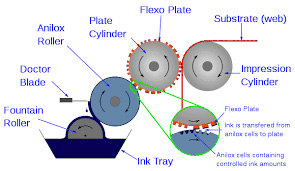What is Flexographic Printing?
Flexography or flexo printing is a printing process that uses rollers and plates to print onto a wide range of substrates. Print quality, high speeds, and large print run capabilities have made flexo printing a trusted label printing technique. The flexographic printing process is popular for labels, cartons, plastic bags, boxes, bottles, and paper towels. Since flexo printing presses can print on paper, plastic, cardboard, fabric, metal, and laminates there are endless flexo printing possibilities.
What is a flexo printing press?
A flexographic printing press is a large printer made up of flexible plates and rollers. Printers traditionally made rubber flexo plates, but now modern technology wraps flexible photopolymer around a roller. When you break it down, a flexo printer works like a giant stamp that can print up to 2,000 feet per minute.
There are 5 types of flexographic printing presses:
- Stack Press: Vertically stacked decks allow for printing on both sides of the substrate.
- Central Impressions Press: There is a central impression cylinder.
- In-Line Press: Decks are in a horizontal line which makes operations easier.
- Wide-Web Press: This flexo press is built to handle wider rolls of substrates.
- Narrow-Web Press: This flexo press is built to handle smaller substrates such as labels.
How does flexo printing work?
The typical flexographic printer has multiple groups of four rollers. The number of groups on a printer is the maximum number of colors that the printer can print per run. A flexo printer can have up to ten different colors and each color requires a unique flexo plate. Based on the printer, a flexographic printing machine could use water-based, solvent-based, oil-based, and UV inks.

A fountain roll is the first of four rollers in the printing sequence. This roller stores and transports the ink. Next up is the anilox roll. The anilox roll releases a specified amount of ink to the plate cylinder. The custom flexo plate covers the place cylinder. When ink comes off the anilox roll, it is pressed directly onto the flexo printing plate. Finally, the flexo printing plate makes contact with the substrate. The material is pushed through the printing press by the impressions cylinder. The pressure and movement provided by the impression cylinder are necessary to create the high-quality prints that flexo printing presses are known for. Once a substrate goes through the plate and impressions cylinder, a drying unit dries the ink before it moves onto the next group of cylinders. This process continues until all ink colors in a project are applied to the substrate.
Go Above and Beyond Ink
If you are looking to level up your packaging and label printing operations, the flexographic printing process is a good option. Other reliable label printing processes include digital label printing and offset printing. At BR Printers, we are proud to have labeling solution options produced in San Jose, CA. Whether you are eager to start printing now or want to learn more about label printing solutions, contact us today.